
Francisco José de Goya y Lucientes was a Spanish romantic painter and printmaker. He is considered the most important Spanish artist of the late 18th and early 19th centuries. His paintings, drawings, and engravings reflected contemporary historical upheavals and influenced important 19th- and 20th-century painters. Goya is often referred to as the last of the Old Masters and the first of the moderns.
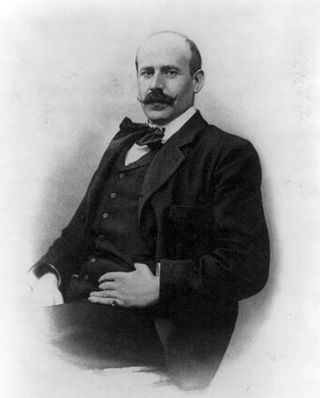
Ignacio Zuloaga y Zabaleta was a Spanish painter, born in Eibar, Guipuzcoa, near the monastery of Loyola.

Fuendetodos is a town in the Campo de Belchite comarca (county), in Aragon, Spain, located about 44 kilometers south-east of Zaragoza. As of 2011, it had a population of approximately 178.

The Museu Nacional d'Art de Catalunya, abbreviated as MNAC, is a museum of Catalan visual art located in Barcelona, Catalonia, Spain. Situated on Montjuïc hill at the end of Avinguda de la Reina Maria Cristina, near Pl Espanya, the museum is especially notable for its outstanding collection of romanesque church paintings, and for Catalan art and design from the late 19th and early 20th centuries, including modernisme and noucentisme. The museum is housed in the Palau Nacional, a huge, Italian-style building dating to 1929. The Palau Nacional, which has housed the Museu d'Art de Catalunya since 1934, was declared a national museum in 1990 under the Museums Law passed by the Catalan Government. That same year, a thorough renovation process was launched to refurbish the site, based on plans drawn up by the architects Gae Aulenti and Enric Steegmann, who were later joined in the undertaking by Josep Benedito. The Oval Hall was reopened for the 1992 Summer Olympic Games, and the various collections were installed and opened over the period from 1995 to 2004. The museum was officially inaugurated on 16 December 2004. It is one of the largest museums in Spain.

Roberto Fabelo, , is a Cuban painter, sculptor, and illustrator.

The Goya Museum is an art museum located in Castres, France. The museum was originally established in 1840 and was named after the Spanish painter Francisco Goya since it specialised in hispanic art from 1947.

The Fundación Picasso, also known as the Pablo Ruiz Picasso Foundation, is a foundation based in Málaga, Andalusia, Spain with the objective of promoting and promulgating the work of the artist Pablo Picasso. They are headquartered in the home on the Plaza de la Merced that was his birthplace, now the Museo Casa Natal, one of the world's many Picasso museums.

Joaquin Mir Trinxet or Joaquin Mir y Trinxet was a Catalan artist known for his use of color in his paintings. He lived through a turbulent time in the history of his native Barcelona. His paintings helped to define the Catalan art movement known as modernisme.

The Birthplace of Simón Bolívar is a seventeenth-century house in the Venezuelan capital city Caracas where the hero of Venezuelan and Latin American independence, Simón Bolívar, was born. Now a significant tourist attraction, the building is located in a little street off the Plaza San Jacinto, a block east of the Plaza Bolívar. It is one of only a few houses from the colonial era which survive in central Caracas.

Fundación Mapfre Casa Garriga Nogués is an art gallery in the Eixample district of Barcelona, Spain. It was established in 2015 and shows early pictorial modern painting and photography (1850–1950) and other photography.
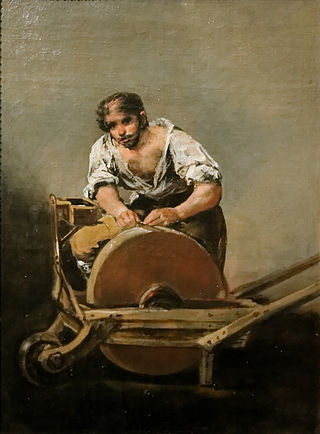
The Knifegrinder is an oil painting on canvas by the Spanish artist Francisco de Goya, from c. 1808-1812. It is now in the Museum of Fine Arts in Budapest.

The Museo Goya - Colección Ibercaja - Museo Camón Aznar is a fine arts museum in Zaragoza, Spain. It opened in 1979 under the name Museo Camón Aznar, after the art collector from the city who had contributed the nucleus of its collection. It houses also a collection of paintings and engravings by Francisco Goya.
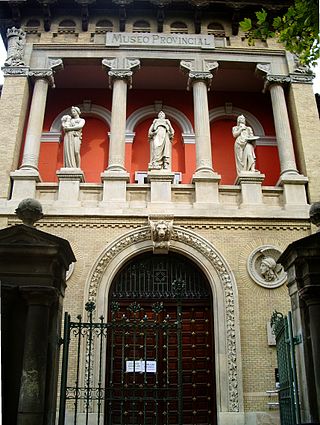
Zaragoza Museum is a national museum in the Plaza de los Sitios in the city of Zaragoza in Spain. Its collections range from the Lower Palaeolithic to the modern era and include archaeology, fine arts, ethnology and Iberian ceramics.
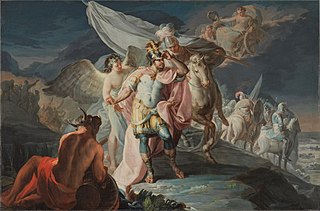
The Victorious Hannibal Seeing Italy from the Alps for the First Time, or Hannibal the victor crossing the Alps, or Hannibal the victorious from the heights of the Alps looks out over the plains of Italy is an oil painting by Spanish painter Francisco Goya, dating from his early years. It is the oldest documented work by the painter.

Self-Portrait at 69 Years is an oil painting by the Spanish painter Francisco Goya. Two original versions of this work have been preserved. One of the paintings, painted on canvas, is housed in the collections of the Prado Museum. The other, created on wood panel, is located in the Real Academia de Bellas Artes de San Fernando in Madrid. Both paintings were created in 1815, in the post-war period, and depict a very similar image of the artist. This is one of the most sincere and direct self-portraits of the painter.

A Village Bullfight or A Village Corrida is an oil painting by the Spanish painter Francisco Goya.
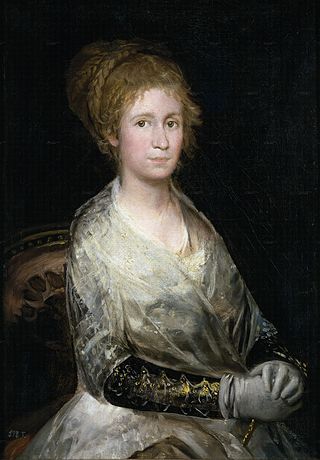
Josefa Bayeu or Leocadia Zorrilla is an oil painting by the Spanish painter Francisco Goya. It is currently housed in the Museo del Prado.

The Museo del Grabado de Goya is an art museum dedicated to the engravings made by Spanish artist Francisco Goya, in Fuendetodos, near Zaragoza, Spain. It is the only museum in the world dedicated entirely to Goya's artworks. It is located right next to the painter's birthplace, and it was inaugurated in 1989.

The Witches' Kitchen is a painting by the Spanish artist Francisco Goya, located in a private collection in Mexico. It is part of a series of six cabinet paintings, each measuring approximately 43 × 30 cm, with the theme of witchcraft. The paintings do not together form a single narrative and do not share a common meaning, so it is appropriate to interpret each one individually. The entire series was owned by the Dukes of Osuna and adorned their summer residence, Alameda de Osuna. In addition to The Witches' Kitchen, the series includes: Witches' Sabbath, Witches' Flight, The Incantation, The Bewitched Man, and Don Juan and the Commendatore. Four of the paintings are in various public collections, one in a private collection, and the last is considered lost.
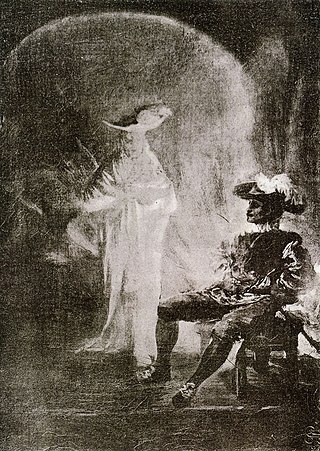
Don Juan and the Commendatore is a painting by the Spanish artist Francisco Goya. It belongs to a series of six cabinet paintings, each approximately 43 × 30 cm, with witchcraft as the central theme. The paintings do not form a single narrative and have no shared meaning, so each one is interpreted individually. The entire series was owned by the Dukes of Osuna and adorned their summer residence in Alameda de Osuna. In addition to Don Juan and the Commendatore, the series includes Witches' Sabbath, Witches' Flight, The Incantation, The Bewitched Man, and The Witches' Kitchen. Four of these paintings are housed in various public collections, one in a private collection, and Don Juan and the Commendatore is considered lost.





















